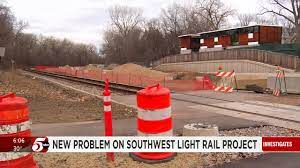The over-budget will be paid exclusively by Hennepin County taxpayers. Hennepin County’s 2023 population was 1,320,307. With a $1,000,000,000 debt that would be about $1,000 of “cost-sharing” owed by each man, woman and child in the county.
SWLRT SNAFU: Southwest Light Rail Train—Situation Normal All “Fouled” Up
Skybridge pedestrian walkway to Bryn Mawr commuter station over freight rail tracks in an ancient Mississippi riverbed, where Penn Avenue dead-ends at I-394.
By Susu Jeffrey / Original to Rise Up Times / March 29, 2024 Updated
About eight percent of Minnesotans suffer with mobility issues (source: Minnesota Public Radio). In a state population of 5.8 million that would include roughly 464,000 individuals.
Navigating the skybridge gauntlet to access the Southwest Light Rail Transit at the Bryn Mawr Station between potential unhoused and drug business folks is a conundrum Minneapolis City Council officials discussed years ago. A cop and cameras was suggested to safeguard commuters walking the 274-foot long, 10-foot wide path over ethanol-carrying BNSF freight trains. An American football field is 300 feet long.
The skybridge terminates at a four-foot-wide stairway of 39 steps, or an elevator if it is working. The light rail transit (LRT) system has had troubles keeping station elevators in service. Seems like a convoluted trip just getting to the train. There is a “kiss and ride” automobile drop off lane but no parking. That means the neighborhood will serve commuter parking with potential stranger-danger incidents. None of the Minneapolis city LRT stations offer park and ride lots.
Bryn Mawr SWLRT Station construction closed the popular Kenilworth Commuter Bike Trail in 2019 and is estimated to reopen about 2027. Southwest Light Rail Transit is years behind schedule and millions, edging up to $1billion, over budget with more years of construction planned. Proposed in 2014, construction began in 2018 with an estimated price of $2billion that ballooned to $2.75 by January 2022.
The over-budget will be paid exclusively by Hennepin County taxpayers. Hennepin County’s 2023 population was 1,320,307. With a $1,000,000,000 debt that would be about $1,000 of “cost sharing” owed by each man, woman and child in the county.
Penny by penny with the new transportation/housing sales tax, it will take a generation to pay off SWLRT. Of course not every county citizen will ride the southwest suburban light rail train, especially if the stations are staffed with drug business and the unhoused. Light rail transportation doesn’t adapt well to grocery shopping, multiple errands or dropping the kids off at school or activities.
The wealthy southwest LRT route from Eden Prairie to downtown Minneapolis is the home turf of state transportation czars Sen. Scott Dibble and Rep. Frank Hornstein, big political supporters of this big-big money project. The late U.S. congressman Martin Sabo labelled the planned route “despicable” compared to transportation needs of black Northside residents. However DFL development enthusiasts ignored the “equity argument” and latched onto that free federal match funding before doing research on the improbable route.
The Route
Originally SWLRT was to run partially with I-394 rather than the narrow urban railroad corridor. The complicated 14.5 mile route includes 29 bridges and 16 new stations. To deal with the “pinch point” of freight rail, Cedar Lake, existing condominiums, townhomes, apartments and single-family homes, the commuter train is being tunneled under heavily traveled Cedar Lake Parkway.
On paper Kenilworth tunnel is designed as a half-mile long “semi-submerged cut-and cover” double LRT track. Met Council’s graphic shows the commuter bike trail on top beside the freight train. City designers are expanding vertically in a neighborhood that is already full horizontally. Urban Minneapolis has run out of land.
Under the surface of Kenilworth land is a glacial deposit of granite boulders pushed southward by the giant ice bulldozer 12,000-plus-years ago. The glacier cleared everything on top the bedrock and pushed it down to Iowa. That’s why we have no native earthworms here.
When trees emerged during the long melt they adapted to slow absorption of leaf litter. Fishers dumping unused bait introduced earthworms that munch the litter faster than native trees can absorb the nutrients—good for gardeners but ignorant of tree needs.
SWLRT planners were apparently ignorant of geologic history in the rush to grab that federal matching billion-dollar grant. So when Kenilworth tunnel excavators hit those hard glacial granite deposits the price went up and the construction slowed down.
The tunnel is planned to surface east of the bottom end of Cedar Lake, just before the Kenilworth channel that now connects Cedar and Lake of the Isles (formerly two separate watersheds). Cedar and Brownie lakes used to empty northward into Bassett’s Creek. City fathers artificially created the “Chain of Lakes” forcing Cedar and Brownie into the Minnehaha watershed which allows pollution to flow downstream from Brownie to Cedar, through Lake of the Isles, Bde Maka Ska and into Lake Harriet.
Subsurface water naturally self-cleans by oozing through sand, soil and gravel. Our urban lakes are becoming scenery where it’s safer to be on rather than in the water. A March 1st communique from Met Council warns neighbors of Kenilworth tunnel construction that “pumps and generators will run overnight periodically in various parts of the construction corridor, especially at the Kenilworth LRT tunnel site. Pumps are used to manage water, and generators are used to power the pumps.” Managing water is one of those human endeavors with a time limit. Consider climate change, for example.
The Minneapolis city portion of SWLRT is proving to be surprisingly expensive. Kenilworth tunnel and Bryn Mawr station located down-bluff in an ancient Mississippi riverbed require creative engineering. To access the low-lying train station a “skybridge” walkway over, above and past freight rail tracks where ethanol trains run must be separated from people trains, not to forget the dense residential population. This area was lakebed, the Cedar Lake Bay that was dewatered and developed into a heavily polluted railyard, since abandoned.
Groundwater collects in the old Cedar Lake Bay, looking toward downtown Minneapolis. New prairie mansions top “the Devil’s Backbone,” probably renamed Native sacred land by Christian settlers.
The memory of old Mississippi water shows in a shallow pool east of the Bryn Mawr Station. Expected climate-change rain-bombs need runoff space with electric trains running back and forth.
Urban Redevelopment
Large housing blocks are being constructed near the LRT route like a senior apartment and townhome complex developed privately, overlooking I-394 in Bryn Mawr. In suburban Hopkins along Blake Road clever manager/bankers of the Minnehaha Creek Watershed District parleyed Minnehaha Creek watershed quality protection into a profitable senior village. Minnehaha Creek Watershed District was the final public agency to approve the SWLRT plan before construction began.
And before construction began inadequate route research led to the cost overage of fantasy engineering and SNAFU change orders. From March 2019 to October 2022 there were 658 change orders due to “unforeseen” conditions. For example, a large grain silo conversion development, Cedar Isles Condos, is a mere inches from LRT construction. Cracks resulted. Residents launched a private study. Construction was halted.
Construction restarted
SWLRT began as a “transportation project” but after delays—many hundreds of change orders, a metastasizing budget, a legislative audit—the language switched to a more realistic “jobs project.” SWLRT is the most expensive public works project ever proposed in Minnesota.
Pinch-point tunnel entrance between townhomes and grain silo condominiums
Too Invested to Fail
For nearly 20 years while citizens researched and Republicans railed against the SWLRT package the Metropolitan Council’s PR department fired up its manufacturing consent machine. Facts notwithstanding, citizen opposition was cursed with the NIMBY label. Instead of fairly servicing the predominately black Northside, the white southwest side of Minneapolis was ridiculed. The late Congressman Martin Sabo’s “despicable” comment on SWLRT was buried. In the state of Minnesota-nice, racism is quietly, politely unmentionable.
Met Council’s charm campaign began with evening information meetings with internet cookies. We were organized cafeteria-style in lines that shuffled us past pieces of the $2 billion proposed project hosted by overtime employees with maps and full-color mock-up drawings. There was no auditorium where we could sit together and collectively air our issues.
After intro meetings the email flurry began and continues. An endless, detailed, grocery list is parsed out like little ceramic squares with objective language like we will close (blah-blah) road for two years to complete underground infrastructure work. Not even a “sorry about that inconvenience.”
The extensive website is a study in piecemeal construction vernacular. State Rep. Frank Hornstein was gung-ho from the get-go pro-SWLRT. He is retiring just before the bill hits the voters. Not one of the four wanna-be replacements for Hornstein’s state rep seat mentioned “environment,” “climate change” or “SWLRT” at a recent DFL caucus in Bryn Mawr that I attended.
State Sen. Scott Dibble says it’s too late to stop putting more tax money into the project; however, the decision is up to the unelected Met Council. Politically, the current 17 members of the greater Twin Cities regional council are governor-appointed (or reappointed) until January 2027. Minneapolis has three council members, St. Paul two, 11 represent surrounding suburbs from the seven-county area, plus the chairperson.
Problems with the Met Council are that it is dominated by suburban votes and it makes policy but not payments. The concept is coordinated transportation, water and housing decisions. The reality is charging stuff on a credit card that you don’t have to pay for.
It turns out that Met Council decisions on SWLRT were made on the basis of political noise. Hennepin County insisted on the hyper-overpriced Kenilworth “transportation corridor” instead of the Uptown route that has more population, transit-dependent residences, jobs, and destinations. St. Louis Park refused to consider freight rail rerouting so now the ethanol trains require thick concrete crash barriers between freight and people rail cars.
For years when Dibble and Hornstein were challenged to stop and reassess the project since its 2014 inception they always claimed we would have to reimburse the federal government for the initial matching billion anyway. Is this corruption, dogged pursuit of a great vision or business-as-usual?
There is an a priori argument against building a light rail transit system in a middle-sized Midwest metro area with only a few million population. While waiting for LRT cars to roll by it’s usually easy to count the few passengers. Fixed rail is great in New York, London and Tokyo but pricey for our sparce ridership here in the Mini Apple.
“Southwest Light Rail is a boondoggle of historic proportions, and the Metropolitan Council has utterly failed in its management of the project,” Senate Transportation Committee Ranking Republican member John Jasinski (R-Faribault) declared in March 2023. “We have no confidence in the Metropolitan Council to properly manage or complete the project, let alone to do so with any fiscal prudence or at any value to the taxpayers.”
SWLRT has blown up the DFL schism between environmentalists and pro-development camps. Since Minneapolis is a one-party town the blame game gets personal. Peter McLaughlin is the main victim so far since he is already out of office but there is plenty of blame to go around. Project decisions belong to the appointed Metropolitan Council but the state legislature assigned the bill to the people who have no vote on SWLRT.
Political SNAFUs like the Kmart/Lake Street closing of Nicollet Avenue or prohibition, abortion politics or even World War I, take a long time and a lot of money to stop. With big-big money no one in authority wants to say “Oops. Sorry. Re-do.” We may have to wait a generation until the SWLRT debt is paid and the deciders are long gone.




